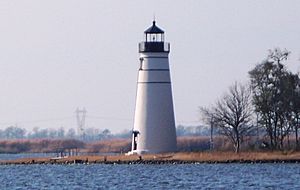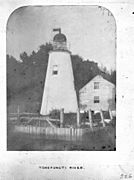Tchefuncte River Range Lights facts for kids
 |
|
|
|
|
| Location | Mouth of the Tchefuncte River, Louisiana |
|---|---|
| Coordinates | 30°22′46.7″N 90°10′08.8″W / 30.379639°N 90.169111°W |
| Year first constructed | 1838 |
| Year first lit | 1868 (current tower) |
| Automated | 1952 |
| Foundation | Stone |
| Construction | Brick |
| Tower shape | Conical |
| Markings / pattern | White with black vertical stripe, black lantern |
| Focal height | 49 feet (15 m) |
| Original lens | 5th order Fresnel lens |
| Current lens | 9.8 inches (250 mm) |
| Characteristic | Isophase White 6s |
| Fog signal | none now, bell in past |
| USCG number | 4-10145 |
|
|
|
| Coordinates | 30°22′42.55″N 90°10′10.16″W / 30.3784861°N 90.1694889°W |
|---|---|
| Year first constructed | 1838 |
| Tower shape | Skeleton tower |
| Markings / pattern | |
| Focal height | 25 feet (7.6 m) |
| Characteristic | Quick flashing white |
| Fog signal | none |
| USCG number | 4-10140 |
The Tchefuncte River Range Lights are a range that was first established in 1838 to aid vessels entering the Tchefuncte River from the north side of Lake Pontchartrain, Louisiana. The lighting apparatus was supplied by Winslow Lewis and consisted of nine lamps with several fourteen-inch reflectors. The original rear tower suffered during the Civil War and was replaced with the current tower in 1868. The new tower, ten feet taller than the first, was built on the same foundation, using some of the same brick. It was given a lantern which had been removed from Cat Island Light in Mississippi.
The rear tower has a black vertical stripe to serve as the range line in daytime. It sits on a spit of land, but is accessible only by boat. The front tower is marked with a standard USCG KRW daymark, with a red stripe between two white stripes. It is a skeleton tower and sits in open water.
The rear tower was added to the National Register of Historic Places in 1986. The Lake Pontchartrain Basin Maritime Museum is making efforts to restore and stabilize the light.
The Light List spells the river name "Tchefuncta", but that's in conflict with the U.S. Board on Geographical Names






